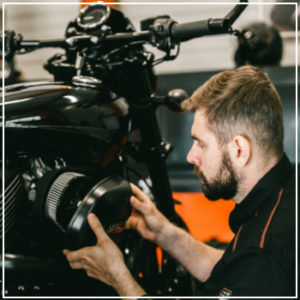
When your car, motorcycle or truck needs an inspection or repairs, many of us have an auto shop or mechanic we trust. Yet for basic maintenance, you might find that doing certain tasks yourself can be more affordable and convenient.
Even if you’re new to motorcycle maintenance, the owner’s manual can help familiarize you with basic upkeep, including the following tasks.
Changing the Oil
If you already change the oil in your car or truck, you can do the same for your motorcycle. To start, reference the owner’s manual for the type of oil recommended for your bike and the ideal number of miles between oil changes.
As you’re preparing to change the oil, start the motorcycle for a few minutes to get the fluid flowing and decrease its viscosity.
You should also prepare to change the oil filter, during which the fluid will drain from your bike. At this point, you can add the new filter, replace the drain and oil plugs, and replenish with the proper type.
Changing the Coolant
Coolant helps prevent your engine from overheating when it’s hot in the summer, freezing in the winter, and guards against corrosion.
Drain the old fluid first, which will require you to remove the drain bolt. You can then add new coolant to the system. To ensure you have added the proper amount, restart the bike right afterwards, turn it off quickly and check the coolant level again.
Replacing the Air Filter
This part filters out debris and other particles that could clog the engine and impact its performance. One of the more challenging maintenance tasks to do on your own, the air filter is not always accessible depending on the model. You may need to remove the gas tank to access the air box and the filter.
Checking Tire Pressure and Treads
The tires are your bike’s contact point with the ground. If they are over or underinflated, you risk a tire blowout or hydroplaning. Worn-down treads can also decrease the bike’s traction.
For basic maintenance, you’ll first want to check the tire pressure by removing the cap from the valve stem and placing a pressure gauge on top. Check the owner’s manual or inside the tire wall for the proper PSI. If the pressure has dropped below the recommended level, you can use an air compressor to fill it to the appropriate PSI before replacing the cap.
At the same time, look over the treads at the center of the rubber. Your tires have a tread indicator, which emerges from the grooves when the rubber has worn down too far. If it sits at the same level as the treads, your tires don’t have enough traction.
If you’re changing your motorcycle’s tires for the first time, you’ll need to update other parts in the process, including the inner tube or valve stem and wheel weights.
Cleaning the Chain
The chain often gets overlooked, although it’s crucial to your bike’s operation. Newer O-ring style chains require less cleaning than older models but you should still read the owner’s manual to know when the chain needs to be wiped down and lubed.
To do this yourself, use a soft-bristled brush to loosen any dirt and debris. Then rotate the back wheel to evenly coat the chain, including all joints. After you’ve covered the surface, let the solution sit for about five minutes before wiping off the excess.
Basic Battery Maintenance
If you don’t feel comfortable changing the battery, you can still check the charge with a multimeter or battery tester. In general, you should keep track of how long your bike has had its current battery.
Similar to a car, vehicle batteries are meant to last an average of five years; the manufacturing date should be listed on a sticker. Also get in the habit of cleaning the terminals and scrubbing off any corrosion.
Inspecting the Brakes
Brake repairs can get complicated but it’s easy to see when the existing set should be replaced. With your bike off the ground, examine the thickness of the brake pads. The owner’s manual will indicate how thick they should be. Also check to see if the material is wearing out evenly.
Next, rotate the wheels to see if the rotors are warped or show any signs of scoring or glazing. As you do this, also inspect the brake lines for signs of wear. Premature wear can occur, although sets should typically last at least five years.
Do you have any tricks for performing basic motorcycle maintenance? Visit our Facebook page to share your tips!
